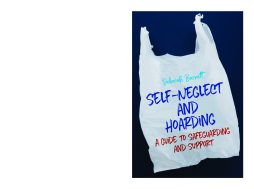
Additional Information
Book Details
Abstract
Self-neglect and hoarding is present in 1 of 5 social work cases in mental health and older people's services. These cases can be the most alarming and challenging on a social worker's caseload.
A skilled, thorough risk assessment of the behaviours of self-neglect is needed in order to ensure effective care and support is available. This guide offers practical and applicable tools and solutions for all professionals involved in working with people who self-neglect. It includes tips for assessment and decision-making in the support process, and updates following the implementation of the Care Act 2014, which deemed self-neglect a safeguarding matter.
Self-Neglect and Hoarding contains much of the information practitioners will need in working with self-neglect. Barnett's emphasis throughout is on a person-centred approach to this important issue.
Dr. David Orr, Senior Lecturer in Social Work, University of Sussex
This book is a further step towards building a successful long-term management strategy for self-neglect and hoarding, rather than just a guide focusing on resolving the obvious, outward manifestations. It provides a great example of a 'journey of support' for the affected individual whilst not forgetting the legal obligations and moral duties of professionals. I'm confident, with the toolkit for a patient centred approach outlined in this book, our management of this disorder, with its considerable societal risks, will improve dramatically.
Dr. Roberta Caiazza, HCPC registered Senior Clinical Psychologist
Table of Contents
| Section Title | Page | Action | Price |
|---|---|---|---|
| Self-Neglect and Hoarding: A Guide to Safeguarding and Support, by Deborah Barnett | 2 | ||
| Preface – A Word from the Philosophical | 9 | ||
| Prevention versus protection | 11 | ||
| Therapeutic needs assessment versus needs assessment | 13 | ||
| Individual social work versus individual, family and community social work | 13 | ||
| Personalised safeguarding versus risk management | 14 | ||
| Assessment – how much is enough? | 15 | ||
| Ethics and values | 16 | ||
| Introduction – An Overview | 19 | ||
| 1. What is Self-Neglect and Hoarding? | 31 | ||
| Defining self-neglect and hoarding | 31 | ||
| Hoarding disorder | 35 | ||
| Is it collecting or is it hoarding? | 37 | ||
| Attachment to objects | 38 | ||
| Sorting and organising | 40 | ||
| Links with other diagnoses | 42 | ||
| When to consider a referral for diagnosis | 42 | ||
| 2. How Self-Neglect Affects People’s Lives | 45 | ||
| Fire | 45 | ||
| Falls | 46 | ||
| Housing | 47 | ||
| Physical and mental health | 49 | ||
| Families and carers | 51 | ||
| 3. Themes from Adult Serious Case Reviews or Safeguarding Adult Reviews | 53 | ||
| Ethical decision-making considerations | 54 | ||
| Identifying self-neglect | 61 | ||
| Care Act compliant enquiries (S42) | 64 | ||
| Risk to others | 66 | ||
| Risk assessment | 68 | ||
| Carers’ assessment | 70 | ||
| Mental health and substance misuse | 71 | ||
| Capacity and consent | 72 | ||
| Advocacy and representation | 76 | ||
| Multi-agency response | 77 | ||
| Comprehensive and holistic assessment | 79 | ||
| Compliance and insight | 81 | ||
| Imposed sanctions, imposed compliance or penalties | 82 | ||
| Information sharing | 83 | ||
| Personalised safeguarding | 84 | ||
| Management support and response | 85 | ||
| Defensible decision making | 86 | ||
| Other | 88 | ||
| 4. Safeguarding those who Self-Neglect under the Care Act 2014 | 90 | ||
| The safeguarding referral | 90 | ||
| Eligibility criteria for safeguarding adults | 91 | ||
| Principles of safeguarding | 94 | ||
| Information recording and sharing | 101 | ||
| How the local authority responds | 103 | ||
| Defensible decision making | 105 | ||
| The Care Act and information sharing | 110 | ||
| The Crime and Disorder Act 1998 | 112 | ||
| Case law judgments | 112 | ||
| Ten steps to information sharing | 113 | ||
| 5. Therapeutic Interventions | 116 | ||
| Building a rapport | 118 | ||
| Trauma, abuse, neglect, loss and bereavement | 120 | ||
| Systemic approaches | 125 | ||
| The cycle of change | 126 | ||
| Solution-focused assessment | 134 | ||
| The beginning of assessment | 137 | ||
| 6. Assessment and Engagement | 139 | ||
| What is a good assessment? | 139 | ||
| Risk assessment | 140 | ||
| Assessing capacity | 152 | ||
| Competency | 154 | ||
| Comprehensive assessment | 157 | ||
| Person-centred assessment | 163 | ||
| An example of a safeguarding adult referral and assessment | 186 | ||
| Self-assessment | 201 | ||
| 7. Supporting the Practitioner | 212 | ||
| Creating social work strategies that are supportive | 212 | ||
| Social work intervention models | 217 | ||
| Case loads and austerity | 227 | ||
| 8. Conclusion | 229 | ||
| Final checklist | 238 | ||
| Epilogue: A Final Thought from the Philosophical | 245 | ||
| References | 255 | ||
| Subject Index | 259 | ||
| Author Index | 263 |
